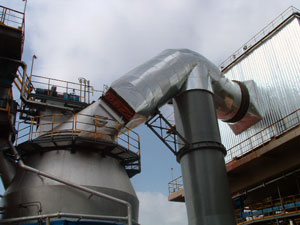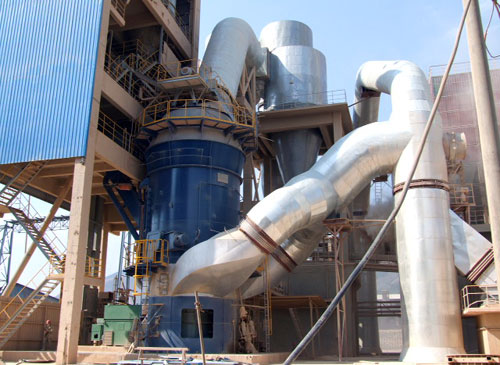Raw material grinding is a critical mechanical operation predominantly determining the sizing of equipment in a cement plant. Raw grinding process consumes about 20% of the total energy consumed in the plant. Various grinding systems used in Indian cement industry for raw material grinding are:
- a) Ball mills
- b) Vertical Roller Mills (VRM)
- c) Ball mills with high pressure grinding rolls.
- d) High pressure grinding rolls
- e) Horizontal roller mills
Selection of type of grinding mill depends on the raw material’s several physical characteristics most important amongst which are hardness of the material and moisture content. Availability of the major grinding equipment in appropriate capacity decides complexity or otherwise of layout, auxiliary equipment sizing etc. which ultimately decide plant’s pyro-processing capacity.
Vertical roller mills have been widely accepted for combined grinding and drying of moist raw materials in view of their excellent drying capacity and low energy consumption. Although the principle of the vertical roller mill did not change over the years, many improvements have been made in design of mill and other equipment in the grinding circuit resulting in less energy consumption and improved reliability. Introduction of external re-circulation of material, adjustable louvre ring and modification of mill body to improve the air and material trajectories are examples of such design changes.
While a number of plants are still using ball mills, many have installed pre-grinders like roller press to improve energy efficiency. Here, the extent to which the roller press is loaded determines the efficiency of the grinding circuit. Use of roller press alone as a finish grinding equipment to give the final product is also a new development.
Horizontal roller mill is yet another improvement in grinding systems incorporating the advantages of vertical roller mill and roller press. An additional advantage with the horizontal roller mill is its low space requirement due its compact size. A compact horizontal roller mill with an in-built separator is now in the process of development. This kind of a mill would eliminate many small conveyors carrying material to separator and from separator.
The efficiency of the grinding circuit and power consumption of the mill fan greatly depend on the performance of the classifier. Perhaps classifier is the part that has undergone maximum changes and has been the target part for efficiency improvement. A variety of high efficiency classifiers are employed in grinding circuits.
Apart from the main equipment viz., mill, classifier and fan the efforts have been on improving the performance of internals e.g. table liners in case of vertical roller mills and classifying liners in case of ball mills. Use of mechanical conveying systems like bucket elevators is becoming more common in place of pneumatic conveying giving substantial savings in energy.
Pyro-processing
Pyro-processing section in a cement plant comprises preheater, rotary kiln and clinker cooler. Pyro-processing section is considered to be the heart of a cement plant as actual cement clinker formation takes place in kiln. The size of a cement plant is determined based on pyro-processing section and the sizes of all other equipment are determined to match pyro-processing. The shape of cement plants changed with the advent of preheater in 70′s. With the introduction of pre-calciners in 80′s, the size of cement plant had considerably increased. A 600 tpd considered to be economic size of kiln earlier went up to 3300 tpd in 80′s and further to 7000 tpd currently. A variety of preheaters with different designs of precalciners have come into existence.
Preheaters can be classified into the following 5 categories irrespective of the manufacturer.
- a) preheater without calciner
- b) inline calciner with air passing through the kiln
- c) inline calciner with external tertiary air duct
- d) separate line calciner
- e) separate line calciner with inline calciner
With the above five modes of operation, different equipment manufacturers came out with different designs normally designated in the manufacturing company’s name. Cyclones are basic units in a preheater system. Pressure drop and change of temperature of gas across each stage determines the efficiency of cyclones. Introduction of Low Pressure drop (LP) cyclones has brought the pressure drop across each stage to around 50 mm WG from around 150 mm WG in conventional cyclones. This has resulted in more and more plants adopting 5 or 6 stages of preheater. A typical 6 stage preheater with LP cyclones will have a preheater exhaust gas temperature of around 2500C and draught of around 500 mm WG. This in turn lead to decrease in preheater fan power consumption. The reduced temperatures at preheater exhaust contribute to environmental improvement.
The burners also play an important role in determining the thermal efficiency of the pyro processing system. There has been a continuous effort on operating the burners with the least possible primary air. The advent of multi-channel burners taking only 5% primary air are being installed in many plants giving a direct thermal energy saving of 15 kcal/kg clinker. Apart from saving thermal energy, the modern burners also enable easy flame control.
Clinker cooler is a critical equipment and the size of clinker cooler some times becomes a bottle-neck for increasing production from rotary kiln. The function of a clinker cooler in a cement plant is dual i.e. reducing the temperature of the clinker to a level that is acceptable for further transport and grinding and recover energy from the sensible heat of the hot clinker by heating the cooling air. Thus thermal efficiency of clinker cooler is very important in deciding about the type of cooler. Mainly two types of clinker coolers are used at present in cement industry.
They are
- a) Grate cooler
- b) Planetary cooler
In majority of the existing plants, conventional grate coolers are used. These coolers have lower recuperation efficiency, occupy more space and need more cooling air. Inspite of these draw backs, grate coolers are more widely used than planetary coolers primarily due to comparatively higher thermal efficiency. There have been a number of design improvements in grate coolers in recent times, mainly on grate plate to improve the efficiencies simultaneously reducing the cooling air intake. The specific load of clinker on grate plate can be as high as 50 tpd/m2. These modern coolers are compact in size. High efficiency coolers operate on the principle of Horizontal aeration. More and more cement plants with conventional grate coolers are retrofitting the coolers with high efficiency coolers.
By installing high efficiency coolers, it is possible to reduce the cooling air to about 1.8 Nm3/kg clinker from conventional value of more than 3 Nm3/kg clinker. This has resulted in low electrical energy consumption in cooling air fans and also in cooler ID fan. Thus high efficiency coolers give rise to both thermal and electrical energy conservation.
The inlet and outlet seals of kiln are important, as they help to reduce the air infiltration into the system. With the improved kiln seals available today, not only heat loss is reduced but also the environment around kiln has become almost dust free. A pneumatic seal for kiln inlet and spring loaded mechanical seal for kiln outlet are considered to be very effective in modern kilns.
Cement Grinding
Cement grinding is another energy intensive operation in cement manufacture Cement grinding consumes around 25-30% of the total energy consumed in a cement plant. Typical cement grinding systems in use are
- a) open circuit mills
- b) closed circuit mills
- c) roller press with open circuit ball mill
- d) roller press with closed circuit ball mill.
- e) roller press in finished mode
- f) vertical roller mill
- g) horizontal roller mill
Ball mills have traditionally been in use for many years in open circuit and closed circuit mode. In recent past, roll press as pre grinders have been introduced. This has given a substantial benefit in energy consumption. Use of vertical roller mill for cement grinding is very recent and the performance results are reported to be encouraging. A typical modern cement grinding circuit will have a roll press as pre grinder with ball mill. Horizontal roller mills combine the advantages of roll press and vertical roller mill. These mills are reported to be highly energy efficient. Horizontal roller mills are best suited for slag grinding.
Separator is crucial equipment in cement mill section as it has direct bearing on production and quality of cement and energy consumption. High efficiency separators are used in modern cement plants and old plants are also going for a retrofit.
Auxiliary items like mill liners and diaphragms have been improved continuously and these items in different designs are available contributing to energy reduction in cement grinding.



